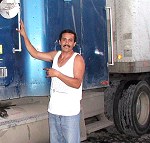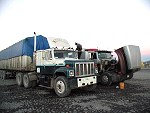|
By accessing or using The Crittenden Automotive Library™/CarsAndRacingStuff.com, you signify your agreement with the Terms of Use on our Legal Information page. Our Privacy Policy is also available there. |

Travel Limitations On Mexican Trucks May Be Lifted By US
|
|---|
|
|
Travel Limitations On Mexican Trucks May Be Lifted By US
Greg Flakus
November 12, 2002
 Listen to Travel Limitations On Mexican Trucks May Be Lifted By US - RealPlayer - 599KB - 4:51
Listen to Travel Limitations On Mexican Trucks May Be Lifted By US - RealPlayer - 599KB - 4:51

Luis next to his truck

Mexican trucks undergoing maintenance
|
A bone of contention between Mexico and the United States in recent years has been the U.S. limitation on Mexican truckers crossing the border, despite of a provision in the North American Free Trade Agreement that allows more access. A decision by President Bush that would permit at least some Mexican trucks to travel on U.S. highways is expected soon.
Standing by his 18-wheel rig at a service center, truck-driver Luis complains about the U.S. restrictions on Mexican trucks.
He says it is not right and that the U.S. policy should change.
In fact, the policy may change sometime in the coming months. The Transportation Department has concluded a study of the situation and is expected to make a recommendation to President Bush, after which he is expected to lift the ban on Mexican trucks doing long-haul operations over U.S. highways.
But critics remain cautious and concerned over safety issues. Mexican truck drivers like Luis represent part of the problem. He makes the 1,200 kilometer drive from Mexico City to Nuevo Laredo three times a week, sometimes bringing his wife and four small children along with him in the cab.
Many Mexican drivers are required by their employers to move cargo as fast as possible and therefore do not take time for a good night's sleep along the route.
Rob Black, a spokesman for the U.S. Teamsters Union, which has argued in the past against the entry of Mexican trucks, says labor and environmental rules south of the border are not as strong as those in the United States. "Certainly, the data has shown that drivers in Mexico, since they do not have basic protections, do drive 18 hours or more, without a break, for third world wages, and that certainly is a concern," said Rob Black. "However, the Teamsters were instrumental in getting safety standards passed through the Congress that ensure that when the border is opened, that whatever trucks from Mexico cross, that those trucks and drivers meet U.S. standards, which is what we were fighting for the whole time anyway."
Mexican officials have complained that inspections of trucks from their country are far more stringent than those imposed on Canadian trucks, which have been able to enter the United States for more than 20 years. Mexican trucks are still limited to a zone that extends to about 30 kilometers north of the border.
But Mr. Black says that is justified since Canada's trucking system is much more like that of the United States.
One longtime advocate of allowing Mexican trucks to do long-haul operations in the United States is Jose Martinez, a consultant with the Free Trade Alliance in San Antonio, Texas. "Do we want unsafe trucks in our community in San Antonio? Of course not. That is nonsense," said Jose Martinez. "We would never promote any program that would allow unsafe trucks to come to our community. My family drives through San Antonio. What we want is a process where those issues are taken care of."
Mr. Martinez says the only low-standard Mexican trucks that come over the border now are the short-haul drayage trucks that take cargo across the line to be transferred to U.S. truckers. He says an opening at the border would allow a better class of Mexican trucks to transport goods across the United States. "When we went into Mexico and looked at a lot of the trucking companies, we found state-of-the art companies, especially around Monterrey," he said. "These are smart business people who understand what the standards are in the United States and most of the fleet, most of the equipment is United States made anyway."
Mr. Martinez says an opening to such sophisticated Mexican trucking operations would bring benefits in terms of efficient delivery and added commerce for transportation hubs like San Antonio.
Planners in San Antonio want to develop what they call an "inland port." They see their city as ideally located, 160 kilometers north of the Laredo border crossing, and about 385 kilometers north of Mexico's major industrial city, Monterrey.
If and when President Bush makes an announcement to open the border to Mexican trucks, San Antonio hopes to profit by providing a rest stop and cargo management facility for the Mexican drivers.



















 Listen to Travel Limitations On Mexican Trucks May Be Lifted By US - RealPlayer - 599KB - 4:51
Listen to Travel Limitations On Mexican Trucks May Be Lifted By US - RealPlayer - 599KB - 4:51


